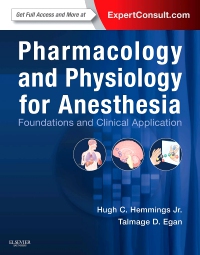
Pharmacology and Physiology for Anesthesia, 1st Edition
Hardcover

Now $139.50
Better understand the complexities of pharmacology and physiology relevant to your practice with the brand-new medical reference book, Pharmacology and Physiology for Anesthesia. Drs. Hugh Hemmings and Talmage Egan provide the clinical insights you need to effectively administer anesthesia, ensuring patient safety and the most optimal outcomes.
"...This is a useful well-written textbook of pharmacology and physiology. There is a greater emphasis on the pharmacology, but both sciences are dealt with to a high standard...I am happy to recommend this book as a useful learning and reference source." Reviewed by: C.S Reilly on behalf of British Journal of Anaesthesia, Feb 2014
-
- Access comprehensive, continually updated research on the physiology of organ systems and clinical topics in the pharmacology of anesthetic drugs.
- Quickly and easily reference the information you need through user-friendly tables, figures, and algorithms, all presented in lavish full color throughout.
- Understand the molecular mechanism of drug actions and identify key drug interactions that may complicate anesthesia with dedicated sections on these key areas.
- Search the text and download images online at Expert Consult.
-
Section 1: Basic Principles of Pharmacology
Chapter 1: Mechanisms of Drug Action
Chapter 2: Pharmacokinetic and Pharmacodynamic Principles for Intravenous Anesthetics
Chapter 3: Pharmacokinetics of Inhaled Anesthetics
Chapter 4: Drug Metabolism and Pharmacogenetics
Chapter 5: Pharmacodynamic Drug Interactions
Chapter 6: Adverse Drug Reactions
Section 2: Nervous System
Chapter 7: Central Nervous System Physiology: Neurophysiology
Chapter 8: Central Nervous System Physiology: Cerebrovascular
Chapter 9: Intravenous Anesthetics
Chapter 10: Pharmacology of Inhales Anesthetics
Chapter 11: Drugs for Neuropsychiatric Disorders
Chapter 12: Autonomic Nervous System Physiology
Chapter 13: Autonomic Nervous System: Pharmacology
Chapter 14: Nociceptive Physiology
Chapter 15: Opioid Agonists and Antagonists
Chapter 16: Non-Opioid Analgesics
Chapter 17: Local Anesthetics
Chapter 18: Neuromuscular Physiology and Pharmacology
Chapter 19: Neuromuscular Blockers and Reversal Drugs
Section 3: Cardiovascular and Pulmonary Systems
Chapter 20: Cardiovascular Physiology: Cellular and Molecular Regulation
Chapter 21: Cardiovascular Physiology: Integrative Function
Chapter 22: Vasopressors and Inotropes
Chapter 23: Antihypertensive Drugs and Vasodilators
Chapter 24: Antiarrhythmic Drugs
Chapter 25: Pulmonary Physiology
Chapter 26: Pulmonary Pharmacology
Section 4: Gastrointestinal and Endocrine Systems
Chapter 27: Liver and Gastrointestinal Physiology
Chapter 28: Nutritional and Metabolic Therapy
Chapter 29: Pharmacology of Postoperative Nausea and Vomiting
Chapter 30: Endocrine Physiology
Chapter 31: Endocrine Pharmacology
Section 5: Fluid, Electrolyte and Hematologic Homeostasis
Chapter 32: Renal Physiology
Chapter 33: Intravascular Volume Replacement Therapy
Chapter 34: Electrolytes and Diuretics
Chapter 35: Blood and Coagulation
Chapter 36: Transfusion and Coagulation Therapy
Chapter 37: Anticoagulant and Antiplatelet Therapy



 as described in our
as described in our 